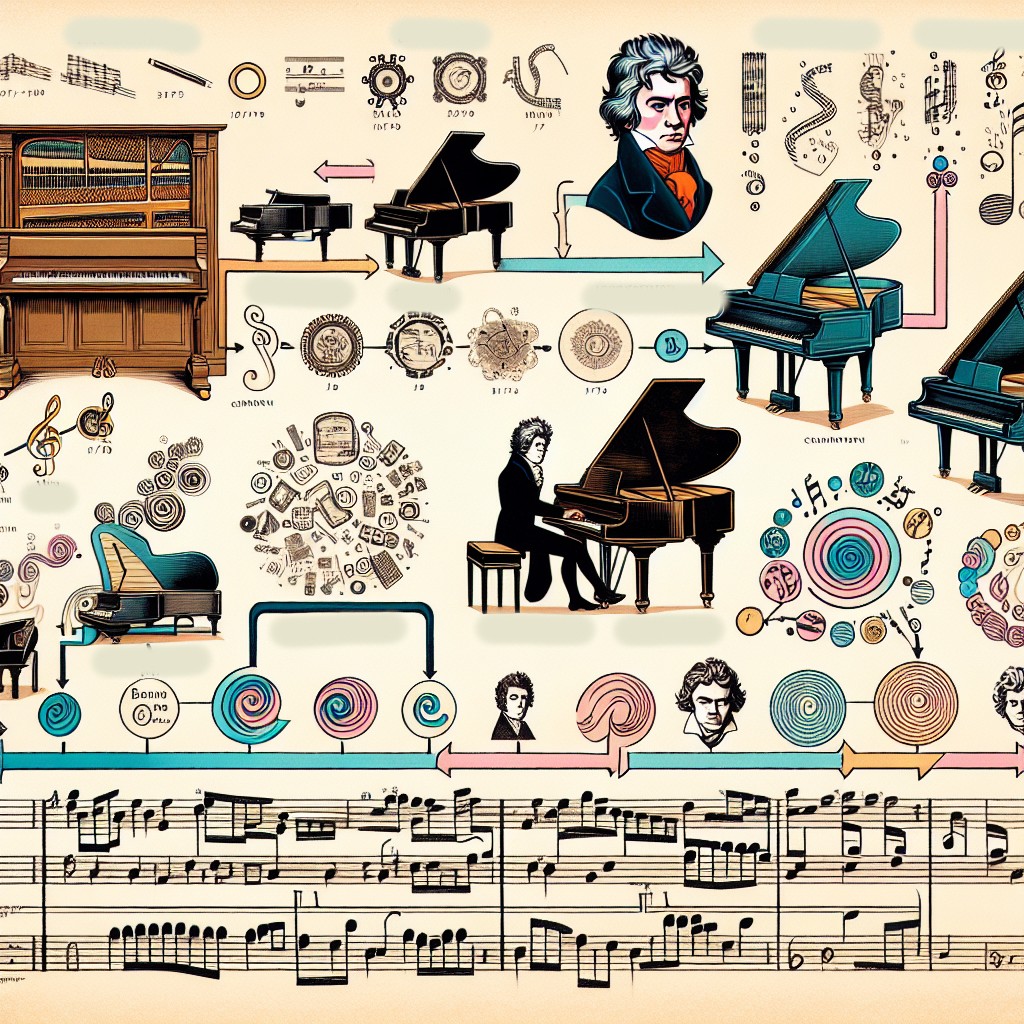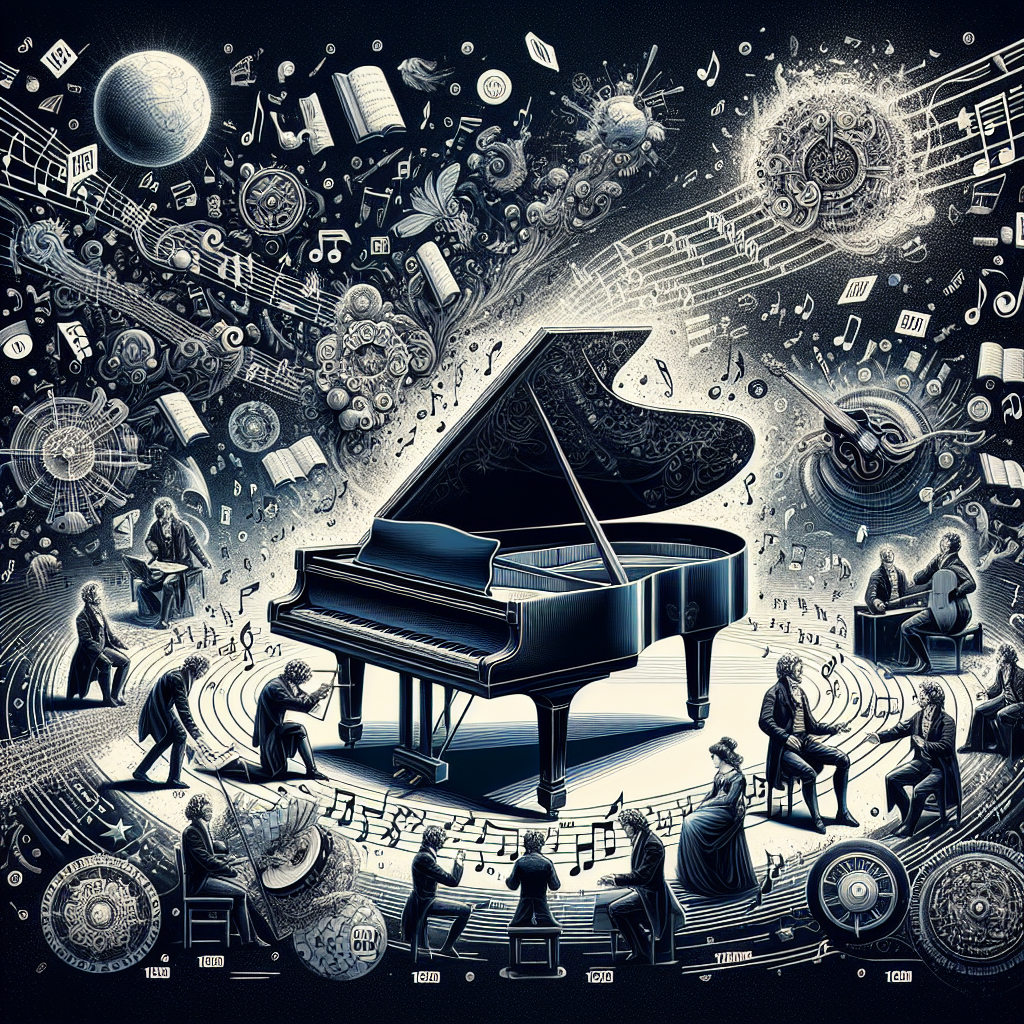
Beethoven’s Revolutionary Contributions to Piano Sonata
In the vast and intricate history of Western music, few figures have cast as profound a shadow as Ludwig van Beethoven. Born in 1770 in Bonn, Germany, Beethoven’s life was characterized by both extraordinary creativity and personal upheaval. He stands not just as a mere composer, but as an emblematic force that revolutionized musical norms and expanded the expressive potential of instruments, especially the piano. In this article, we delve into how Beethoven’s innovations profoundly influenced the development of the piano sonata, shaping it into a cornerstone of classical music.
Introduction
Ludwig van Beethoven’s contributions to music are immeasurable, but his work on the piano sonata is particularly noteworthy. The piano, as an instrument, was undergoing significant changes during Beethoven’s lifetime, evolving from the harpsichord and clavichord into the more dynamic and capable instrument we know today. This transformation offered composers like Beethoven a broader canvas for artistic expression. The sonata form, already well-established by composers like Haydn and Mozart, provided a structural foundation for Beethoven to experiment and innovate.
Beethoven’s early piano sonatas show a deep respect for his predecessors’ traditions, yet even in these works, his distinctive voice begins to emerge. His use of bold harmonic progressions, intricate counterpoint, and dramatic contrasts in dynamics set the stage for more radical developments in his later compositions. Beyond the technical aspects, Beethoven imbued his sonatas with profound emotional depth, breaking away from the more restrained and polished styles of the Classical era. His music often mirrors his own turbulent life experiences, from his struggle with deafness to his philosophical musings on freedom and heroism.
This exploration of Beethoven’s piano sonatas not only highlights his technical innovations but also underscores his role in the broader narrative of musical evolution. By pushing the boundaries of what a piano sonata could express, Beethoven paved the way for future composers and helped elevate the piano to its central role in Western concert music.
Early Years and Initial Works
Beethoven’s early years were marked by intensive study and performance. His father, Johann van Beethoven, recognized his son’s prodigious talent from a young age and pushed him to attain musical greatness. Beethoven’s early exposure to the works of composers like Haydn and Mozart profoundly influenced his initial compositions. Between 1795 and 1801, Beethoven composed his first set of piano sonatas, known as the Opus 2 sonatas, which he dedicated to Haydn.
These early sonatas reveal Beethoven’s mastery of the classical style while also hinting at his desire to expand its boundaries. The Opus 2 sonatas, for example, display greater structural complexity and emotional depth compared to the works of his contemporaries. In his use of dynamic contrasts and unexpected key changes, we see the seeds of the more revolutionary techniques that would come to define his later work. Even at this early stage, Beethoven was beginning to view the sonata not just as a formal exercise, but as a vehicle for personal expression.
In these formative years, Beethoven also began to make a name for himself as a virtuoso pianist, performing in the salons and concert halls of Vienna. His prowess at the keyboard was legendary; contemporaries marveled at his technical skill and expressive power. This dual role as both performer and composer allowed Beethoven to experiment with new sonorities and techniques firsthand, directly influencing his compositional approach to the piano sonata.

Innovations and the Heroic Period
The turn of the century marked a significant shift in Beethoven’s musical style, coinciding with what is often referred to as his “Heroic” period. From 1802 to 1812, Beethoven composed some of his most celebrated piano sonatas, works that fundamentally reshaped the genre. During this time, Beethoven’s personal struggles, particularly his increasing deafness, heavily influenced his music. This period is characterized by bold, expansive structures, and a heightened sense of drama and emotional intensity.
The “Waldstein” Sonata (Op. 53) and the “Appassionata” Sonata (Op. 57) are exemplary of this period. These sonatas showcase unprecedented technical demands and emotional scope. In the “Waldstein” Sonata, Beethoven makes extensive use of rapid chord changes, powerful octaves, and broad, sweeping melodies that test the limits of both pianist and instrument. The “Appassionata” Sonata, with its brooding intensity and explosive contrasts, pushes the boundaries of the conventional sonata form, creating a narrative of tension and resolution that was unmatched at the time.
Beethoven’s innovation was not limited to the technical realm; he also redefined the role of the piano sonata as a medium for profound emotional and philosophical exploration. The use of cyclical themes and motifs across movements, a hallmark of his later sonatas, creates a sense of unity and coherence that deepens the listener’s engagement. In works like the “Les Adieux” Sonata (Op. 81a), Beethoven uses musical motifs to convey a narrative of departure, absence, and return, imbuing the sonata with a programmatic element that was previously unheard of in the genre.
Late Period and Profound Experimentation
The final decade of Beethoven’s life saw the creation of some of his most experimental and forward-thinking works. The late piano sonatas, composed between 1816 and 1822, represent the culmination of Beethoven’s lifelong exploration of the sonata form. These works are characterized by their structural innovation, harmonic complexity, and intense expressivity. The late sonatas are less concerned with virtuosic display and more focused on deep, introspective musical inquiry.
The “Hammerklavier” Sonata (Op. 106) is perhaps the most famous of Beethoven’s late sonatas. Its sheer scale and technical demands make it one of the most challenging works in the piano repertoire. The sonata’s vast scope, intricate fugue, and profound slow movement exemplify Beethoven’s willingness to push the limits of the sonata form. The “Hammerklavier” stands as a testament to Beethoven’s unrelenting quest for innovation and his refusal to be constrained by established norms.
In addition to the “Hammerklavier,” the late sonatas such as Op. 109, Op. 110, and Op. 111 explore new realms of musical expression. These works often blur the lines between different movements, creating a continuous musical journey that defies traditional structural conventions. Beethoven’s use of variation form in the final movement of Op. 111, for instance, transforms a simple theme into an expansive, transcendent exploration of musical possibilities. These late sonatas not only challenge the performer but also invite listeners to engage in a deeper, more philosophical contemplation of the music.
Beethoven’s Legacy
Beethoven’s impact on the piano sonata extends far beyond his lifetime. His innovations paved the way for subsequent generations of composers, from Romantic era giants like Franz Schubert and Johannes Brahms to modernists like Sergei Rachmaninoff and Dmitri Shostakovich. The structural, harmonic, and expressive possibilities that Beethoven unlocked in his sonatas have become integral to the development of Western art music.
Beethoven’s approach to the sonata form influenced not only composers but also performers. The technical demands and emotional breadth of his sonatas require a level of interpretation and expressivity that continues to challenge and inspire pianists to this day. Performers must grapple with Beethoven’s intentions, bringing their unique insights to his timeless works while respecting the profound depth of his compositions.
The enduring popularity of Beethoven’s piano sonatas is a testament to their universal appeal. These works speak to the human condition, capturing a wide range of emotions and experiences in a way that transcends time and cultural boundaries. From the youthful exuberance of the early sonatas to the profound introspection of the late works, Beethoven’s piano sonatas offer a rich and rewarding journey for both performers and listeners, inviting us to explore the complexities of the human spirit through the language of music.
Conclusion
Ludwig van Beethoven’s contributions to the development of the piano sonata are unparalleled. Through his willingness to experiment and push boundaries, Beethoven expanded the expressive and technical possibilities of the sonata form, creating works that continue to inspire and challenge musicians and audiences alike. His early sonatas demonstrate a profound understanding of classical traditions, while his later works reflect a fearless pursuit of innovation and emotional depth.
By transforming the piano sonata into a vehicle for personal and philosophical expression, Beethoven paved the way for future generations of composers to explore new musical landscapes. His legacy lives on in the countless musicians who continue to perform and interpret his works, finding new meanings and connections in his timeless music.
In celebrating Beethoven’s contributions to the piano sonata, we honor not only his genius as a composer but also his enduring impact on the world of music. His works remind us of the power of creativity and the limitless potential of artistic expression, inspiring us to seek our own paths of discovery and innovation. As we listen to and perform Beethoven’s piano sonatas, we partake in a rich tradition that continues to shape our understanding and appreciation of music, connecting us to the past while guiding us toward the future.